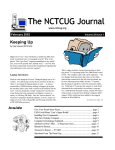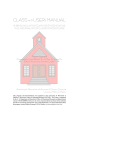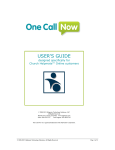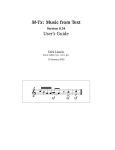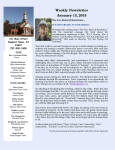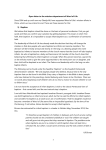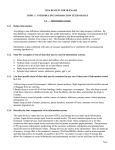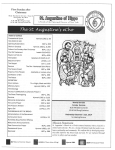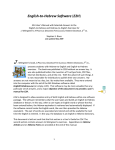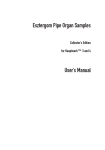Download KREGEL STYLE MANUAL
Transcript
KREGEL STYLE MANUAL
Table of Contents
Special Policies I 2
Bad Breaks/Formatting I 4
Acronyms and Initials I 5
Capitalization—Directions and Regions I 5
Percentages I 5
Photo Captions I 5
Table Title and Column Heads I 5
Time I 5
Quotations and Dialogue I 6
Scripture Quotations I 6
Punctuation I 7
Colon I 7
Comma I 7
Dash I 8
Hyphenation of Compounds I 8
Semicolon I 9
Abbreviations I 9
Books of the Bible I 9
States I 10
Capitalization I 11
Word Usage I 21
Macintosh Symbols I 23
Web/Internet I 24
Indexing I 24
Scripture Indexing I 25
Rights and Permissions I 26
Kregel uses The Chicago Manual of Style, 15th edition, for matters of style and
consistency.
Special Policies
A. Kregel will use gender-inclusive language unless specified differently by an author.
Steps to be taken to make a document more gender inclusive are as follows:
1. Try to rewrite the sentence.
2. Use singular/plural pronoun construction as a last resort (i.e., everyone/their).
B. When questioning the spelling of a word, the first spelling of a word appearing in
Merriam-Webster’s Collegiate Dictionary, 11th edition, should be used.
C. The word gospel is to be lowercased except in the case of referring to “the Gospels”
(all four books as a whole unit). Other words that are generally lowercased are book,
epistle, psalm, proverb, and letter. They should be capitalized only when referring to the
actual title of a book as given in the Bible translation being used.
D. Capitalization of pronouns referring to Deity will be dealt with on a project-byproject basis.
E. Prepositions of five or more letters are to be capped in a title or heading. Prepositions
of four or fewer letters are to be lowercased.
F. Words used as words should be italicized with their definitions (if any) appearing
inside quotation marks. Examples of an exception to this rule are Greek and Hebrew
words, which cannot be italicized. (Transliterations can be italicized.)
Foreign words should appear in italics, with the English translation appearing in
roman font and enclosed in quotation marks. If the translation follows immediately
after the word, it should be enclosed in parentheses.
Examples:
The first line of the song is tumra probutey shorbuda anondo koro, which
means “rejoice in the Lord always.”
The word lu-omen (“we loose”) in table 3.15 illustrates the plural form of
the first person.
G. Smart quotes and apostrophes (“Then he said, ‘I won’t do it.’”) should be used
instead of neutral quotes and apostrophes ("Then he said, 'I won't do it.'").
H. Space is to be put between ellipsis points. See CMS 11.57–11.61 for the three-or-fourdot method.
2
I. A short, direct question included within a sentence need not begin with a capital
letter, but it is still preceded by a comma. (CMS 6.55)
J. Punctuation marks should appear in the same font—roman or italic—as the majority
of the surrounding text (CMS 6.3), except for punctuation that belongs to a title and
exclamation points. (Contrary to CMS, italicize exclamation points that follow an
italicized word.) In rare instances, a book may be styled according to the alternative
system (CMS 6.5). We will accept this styling so long as it is consistent. When in doubt,
query your Kregel contact person.
K. Punctuation following boldface text should be dealt with case by case, depending on
how the word is used. (CMS 6.4)
L. Periods, colons, or any other marks of punctuation should never have more than a
single space after them.
M. Abbreviations, as a front matter section, is to come directly before the text.
N. In plurals of proper nouns that include a generic term, the generic term should be
lowercased (e.g., Fifty-fifth and Fifty-seventh streets, American and French revolutions).
(CMS 8.57, 8.60, 8.121)
O. The policy for capitalization of hyphenated terms in titles of works has been
trimmed down to this: Capitalize only the first element unless any subsequent element
is a proper noun or adjective. Also, one no longer needs to capitalize the last element of
a hyphenated term just because the compound is the last word in a title (e.g., Avoiding a
Run-in). (CMS 8.167–168)
P. Letters representing shapes no longer have to be set in sans serif fonts (e.g., an Lshaped room).
Q. Ordinals should appear as 2nd, 3rd, etc., not as 2d.
R. Notes are not to follow book or chapter epigraphs. An unnumbered note is to be
used instead, if any. A footnote or endnote applying to a chapter epigraph begins with
the word Epigraph in italics, followed by a period; the rest of the citation follows. (CMS
16.66–16.68)
S. On pages with endorsements, use quotation marks around each endorsement. No
comma follows the name before a title if the name is right justified to the margin.
T. A capital X is used in ISBNs with an X as the last digit.
U. Use Jesus’ and Moses’ (contrary to CMS 7.22) unless the project style sheet indicates
otherwise.
3
Bad Breaks/Formatting
Orphan. The last line of a paragraph must contain at least one complete word of three
or more letters.
Widow. A widow is anything less than a full line plus a second line with at least one
word of three or more characters at the top of a page. The first line of a paragraph at the
bottom of a page is acceptable.
Punctuation block. A punctuation block is five or more consecutive lines ending with
punctuation, three or more consecutive lines ending with hyphens. Punctuation blocks
should be marked to be rebroken.
A. The last word of a paragraph should not be broken from one line to the next with a
hyphen. Exceptions can be made for broken compounds that prevent a loose line.
B. The last page of a chapter must contain at least three lines of text.
C. It is an acceptable line break for a line of text (such as a Scripture reference) to be
broken at an en-dash.
D. When Scripture references appear within text, whether in parentheses or out, there
are two specific ways in which the reference cannot be broken. First, a book containing
a number, such as 2 Corinthians, cannot be broken between the number and the book
name. Second, a chapter number and verse cannot be broken. The wrong way:
I love to read. It is important to read the Bible. God’s Word, such as 2
Corinthians 12:9–10, has so much to say.
I love to read. It is important to read the Bible. First Corinthians 12:
9–10 has so much to say.
The correct way:
I love to read. It’s important to read the Bible. God’s Word, such as
2 Corinthians 12:9–10, has so much to say.
I love to read. It’s important to read the Bible. God’s Word, such as John
12:9–10, has so much to say.
4
Acronyms and Initials (CMS 15.3–28)
—Do not use periods in acronyms: UNICEF, not U.N.I.C.E.F.; NAFTA, not N.A.F.T.A.
(An exception is if the organization requires periods.)
—Put a space between initials in a person’s name (C. M. Russell). However, when
proofreading, do not allow initials to be broken up onto separate lines.
Capitalization—Directions and Regions (CMS 8.46–54)
—south-central, north-central, northwestern, southeastern
—Capitalize the word when it is used as a description rather than a direction, as in
Western art, Midwest, the West, Southern California, but western Montana.
—Capitalize the word when it is referring to a specific region of the United States like
the West, the West Coast, the Southwest.
Percentages (CMS 9.19)
—Use numerals and spell out the word percent rather than using the % symbol: 50
percent, 99 percent. Note that “percent” is always preceded by a numeral unless the
numeral begins a sentence, then it’s spelled out.
Photo Captions (CMS 12.31–51)
—Photo captions should take the form of a complete sentence or sentences and should
be capitalized and punctuated appropriately: “The moon rises like a hood ornament along
the Beartooth Highway.”
—All captions should be italicized, set in smaller type, or otherwise distinguished from
the main text.
Table Title and Column Heads (CMS 13.16, 13.19)
—Table titles and column heads should be handled in a consistent manner within the
book: either sentence-style capitalization or headline style.
Time (CMS 9.38, 9.41–42)
—Era designations should appear in small caps and with periods: A.D., B.C.E., B.C., C.E.
(contrary to CMS 15th ed.).
— Make sure that AM and PM appear as small caps: 6 AM (not 6:00 a.m.), 5:30 PM,
“Hours are from 1 to 4:30 PM.”
5
Quotations and Dialogue
A. Direct quotations must be reproduced exactly as shown. See CMS 11.4–10 and 11.68–
71 for information on accepted alterations and how they may be made.
B. When dialogue is faltering, trailing off, etc., a three-dot ellipsis should be used. There
is no reason to use a four-dot ellipsis in this instance.
C. If a word or part of a word is missing (often to disguise a name or occasionally an
expletive), a 2-em dash should be used. See CMS 6.95 for details about how this should
be done.
Scripture Quotations
A. Scripture quotations that are set in block quotation style should have the reference
appearing directly after the final punctuation, set in parentheses. The book name in the
reference should be abbreviated unless otherwise specified. (CMS 11.81) Example:
May I never boast except in the cross of our Lord Jesus Christ, through
which the world has been crucified to me, and I to the world. Neither
circumcision nor uncircumcision means anything; what counts is a new
creation. (Gal. 6:14–15)
B. Scripture quotations set in poetry style should have the reference dropped to the line
after the last line of the quote. This reference should be in parentheses and set flush
right, aligned with the last character of the quote’s longest line. The book name should
be abbreviated unless other specifications are given for an individual project. (CMS
11.83) Example:
For I will forgive their wickedness
and I will remember their sins no more.
(Jer. 31:34)
C. In some scholarly works, when the author wishes to indicate that only a portion of a
Bible verse is being referenced, the letters a, b, c, etc., may be added to that reference.
We prefer that this practice be limited to academic works in which precision is required.
Trade books do not need to indicate verse portions.
6
D. The word verse should be abbreviated “v.” and verses should be abbreviated “vv.”
when within parentheses.
E. There is to be no comma between a Scripture reference and a Bible translation
abbreviation within parentheses (i.e., Gen. 1:1 NIV).
F. Always abbreviate the book name in parenthetical Scripture references. Examples:
(Dan. 6) (Dan. 6:7)
Punctuation
Colon (CMS 6.63–69)
A colon is always preceded by a complete main clause. A colon can be used to
introduce a formal statement, an extract, a subtitle, speech in dialogue, a list, or a series.
Never use a colon to introduce a list that is a complement or an object of an element in
the introductory statement.
Example: “The three bears had porridge, beds, and chairs” not “The three bears had:
porridge, beds, and chairs.”
Capitalizing the first word after a colon is discouraged. The only exceptions are if
the colon is being used to introduce summary information (“General description: This is
a short, easy hike.”), a subtitle (Bear Aware: Hiking and Camping in Bear Country), two or
more sentences (“Henrietta was faced with a hideous choice: Should she reveal what
was in the letter and ruin her reputation? Or should she remain silent and compromise
the safety of her family?”), or an extract (“Julian Duguid, author of Green Hell [1931],
starts his book boldly: ‘When a man yields to the urge of Ishmael . . . ’”).
Comma (CMS 6.18–62)
When using commas, readability is the goal. In general, use a comma where you
would normally pause in saying a sentence aloud.
Use a comma before the last item in a series. Example: “The colors of the American
flag are red, white, and blue.”
An adjectival phrase or a clause that is nonrestrictive or purely descriptive, which
could be dropped without changing the reference of the noun, is set off by commas.
Example: “The girl, whose blue eyes shone with delight, shouted at the weasel.”
A restrictive phase is never set off. Example: “The girl with the blue eyes shouted at
the weasel.”
7
If an author is inconsistent in his/her use of commas before “too,” then standardize
it according to this rule: Use commas with too only when you want to emphasize an
abrupt change of thought:
He didn’t know at first what hit him, but then, too, he hadn’t ever walked
in a field strewn with garden rakes.
In most other cases, commas with this short adverb are unnecessary (an exception being
sentences that begin with too—in the sense of also).
Dash (CMS 6.80–96)
An em dash (—) is the longest dash typically used. It is used to denote sudden
changes, to introduce a phrase that amplifies, explains, or digresses from the main
clause, or to set off a complementary element in a sentence (a job that can also be done
by commas or parentheses). It is less formal than a colon or semicolon. Avoid overuse
of the em dash.
An en dash (–) is shorter than an em dash and longer than a hyphen (-). Its main use
is to connect continuing or inclusive numbers, such as dates, times, or page ranges, or to
create a compound adjective. Examples: May–July 1997, 8–11 AM, Helena–Spokane
flight. In running text (except in cookbooks), use of the word to is preferable. Examples:
May to July 1997, 8 to 11 AM, Helena to Spokane flight.
All dashes are to be closed. Example: “The path is dangerous—use caution” not
“The path is dangerous — use caution.”
If your word processor will not allow you to create em dashes, use two hyphens (--)
instead.
Hyphenation of Compounds (CMS 7.35–45, 7.82–90)
The rules for hyphenating words are complicated. CMS should solve most
problems. Below are some general rules to follow:
Hyphenate adjectives preceding nouns if the meaning may be ambiguous (“a fastsailing ship”).
Hyphenate adjectives preceding nouns if the adjectives are of equal value (“bluegreen algae”).
8
Do not hyphenate when one adjective modifies a second adjective before a noun
(“bluish green paint”).
Hyphenate adjectives plus nouns ending with the suffix -ed whenever the
compound precedes a noun (“coarse-grained wood”; “able-bodied man”; “umbrellashaped flower”).
Semicolon (CMS 6.57–62)
Semicolons are used between the two parts of a compound sentence (independent or
coordinate clauses). Example: “The left fork of the trail leads to the lake; the right fork
takes you back to the trailhead.”
They are also used to separate items in a series when the items themselves are
separated by commas. Example: “For our trip we bought a camp stove, with plenty of
extra fuel; a three-person tent, so we’d have more room; and two sets of water filters.”
Introduce an amplified, explanatory, or digressive clause with an em dash.
Abbreviations
—Periods should be omitted from abbreviations in full caps or small caps, but retained
in lowercase abbreviations (such as e.g., i.e., a.k.a., etc.). One exception is that U.S. retains
the periods. (See CMS 15.5 for other exceptions.)
—Both PhD and Ph.D. are acceptable, so long as they are styled consistently in a given
work.
Books of the Bible
The books of the Bible should be abbreviated when within parentheses. However, if a
book of the Bible appears within parentheses without a chapter number or chapter
number and verse, then it should be spelled out. The following is a list of accepted
abbreviations.
Old Testament
Genesis
Exodus
Leviticus
Numbers
Deuteronomy
Joshua
Judges
Gen.
Exod.
Lev.
Num.
Deut.
Josh.
Judg.
Ruth
1 Samuel
2 Samuel
1 Kings
2 Kings
1 Chronicles
2 Chronicles
9
Ruth
1 Sam.
2 Sam.
1 Kings
2 Kings
1 Chron.
2 Chron.
Ezra
Nehemiah
Esther
Job
Psalm(s)
Proverbs
Ecclesiastes
Song of Songs
Isaiah
Jeremiah
Lamentations
Ezekiel
Daniel
Ezra
Neh.
Esther
Job
Ps. (Pss.)
Prov.
Eccl.
Song
Isa.
Jer.
Lam.
Ezek.
Dan.
Hosea
Joel
Amos
Obadiah
Jonah
Micah
Nahum
Habakkuk
Zephaniah
Haggai
Zechariah
Malachi
Hos.
Joel
Amos
Obad.
Jonah
Mic.
Nah.
Hab.
Zeph.
Hag.
Zech.
Mal.
Matt.
Mark
Luke
John
Acts
Rom.
1 Cor.
2 Cor.
Gal.
Eph.
Phil.
Col.
1 Thess.
2 Thess.
1 Timothy
2 Timothy
Titus
Philemon
Hebrews
James
1 Peter
2 Peter
1 John
2 John
3 John
Jude
Revelation
1 Tim.
2 Tim.
Titus
Philem.
Heb.
James
1 Peter
2 Peter
1 John
2 John
3 John
Jude
Rev.
New Testament
Matthew
Mark
Luke
John
Acts
Romans
1 Corinthians
2 Corinthians
Galatians
Ephesians
Philippians
Colossians
1 Thessalonians
2 Thessalonians
States
The accepted state abbreviations to appear in footnotes/endnotes are as follows.
Alabama
Alaska
Arizona
Arkansas
California
Colorado
Connecticut
Delaware
Florida
Georgia
Hawaii
Idaho
Illinois
AL
AK
AZ
AR
CA
CO
CT
DE
FL
GA
HI
ID
IL
Indiana
Iowa
Kansas
Kentucky
Louisiana
Maine
Maryland
Massachusetts
Michigan
Minnesota
Mississippi
Missouri
Montana
10
IN
IA
KS
KY
LA
ME
MD
MA
MI
MN
MS
MO
MT
Nebraska
Nevada
New Hampshire
New Jersey
New Mexico
New York
North Carolina
North Dakota
Ohio
Oklahoma
Oregon
Pennsylvania
NE
NV
NH
NJ
NM
NY
NC
ND
OH
OK
OR
PA
Rhode Island
South Carolina
South Dakota
Tennessee
Texas
Utah
Vermont
Virginia
Washington
West Virginia
Wisconsin
Wyoming
RI
SC
SD
TN
TX
UT
VT
VA
WA
WV
WI
WY
Capitalization
The following is a list of commonly used religious terms and their proper capitalization.
Aaronic priesthood
Aaronide (genealogy of Aaron)
Abba
abomination of desolation
Abrahamic covenant
Abraham’s bosom
Abraham’s side
Abyss, the
Achaemenid
Adonai
advent, the
Advent season
Advocate, the
Agabah
agape
age of grace
age to come, the
agnosticism
Almighty, the
almighty God
Alpha and Omega (Christ)
amillenarian
amillennial(ism)(ist)
ancient Near East(ern)
Ancient of Days, the (God)
angel (capitalize if theophany)
angel Gabriel, the
angel of the Lord (capitalize if
theophany)
annunciation, the (the event)
Annunciation, the (the holiday)
Anointed, the (Christ)
Anointed One, the (Christ)
anointed Savior
anointing of the sick
ante-Christian
ante-Nicene fathers
anti-Catholic
antichrist (the general spirit)
Antichrist (the person)
anti-Christian
antichurch
anti-God
antilegomena
anti-Semitism
anti-Trinitarian
Apocalypse, the (Revelation of
John)
apocalyptic
Apocrypha, the
apocryphal (cap. only if Apocrypha
is meant)
apostle Peter, et al.
apostles, the
Apostles’ Creed
Apostle to the Gentiles (Paul)
apostolic
apostolic age
apostolic benediction (2 Cor. 13)
apostolic council (Acts 15)
apostolic faith
apostolic fathers (the men)
11
Apostolic Fathers, the (the group of
writings)
Arabah
Aramaean
Archangel
archbishop of Canterbury (but
Archbishop Smith)
ark, the (Noah’s)
ark of the covenant
ark of the testimony
Arminian(ism)
ascension, the
Ascension Day
Athanasian Creed
atheism, -ist
atonement, the
Atonement, the Day of (Yom
Kippur)
Augsburg Confession
Blessed Virgin
blood of Christ
body, the (of Christ)
body of Christ (the church)
Book, the (Bible)
book of Genesis, et al.
Book of Life (book of judgment)
book of the covenant
book of the law
Book of the Twelve, the
Book of Truth
boy Jesus, the
brazen altar
Bread of Life (Bible or Christ)
Bridegroom, the (Christ)
bride of Christ (the church)
brotherhood of man
bulla (plural bullae)
burning bush, the (Exod. 3)
burnt offering
Baal
baalism
babe in the manger, the
baby Jesus, the
Babylonian captivity (Jews)
Babylonian Empire
baptism
baptism, the (of Christ)
Baptist, the (John the Baptist)
battle of Armageddon (final battle)
Beast, the (Antichrist)
beatification
beatific vision (theology)
beatitude, a
Beatitudes, the
bedouin (singular and plural)
Beelzebub
Beelzebul
Begaa
Being (God)
Beloved Apostle, the
betrayal, the
Bible, the
Bible Belt, the
Bible school
biblical
bidding prayer
bishop of Rome (but Bishop Jones)
blessed name (Christ)
Calvary
Calvinist(ic), -ism
Canon, the (Scripture)
canonical
Canonical Epistles, the (James, et
al.)
canonical hours
canonization
canon law
canon of Scripture, the
captivity, the (of the Jews)
catechumen
catholic (universal)
Catholic church (the building)
Catholic Church (Roman Catholic)
Catholic Epistles (James, et al.)
Catholicism
Celestial City (abode of the
redeemed)
charismatic
charismatic church
charismatic movement
cherub(im)
chief priest
Chief Shepherd (Christ)
child Jesus
children of Israel
chosen people (Jews)
12
Christ
Christ child
christen(ing)
Christendom
Christian (n. and adj.)
Christian era
christianize, -ization
Christianlike
Christlike(ness)
Christian socialism
Christmas Day
Christmas Eve
Christmastide
christocentrism
christological
Christology, -ical
christophany
Chronicler, the
church, the (body of Christ)
church (building)
church (service)
church age
church and state
church fathers (the Fathers)
church in America
church invisible
church militant
Church of England
Church of Rome
church triumphant
church universal
church visible
City of David (Jerusalem,
Bethlehem)
Code of Hammurabi
College of Cardinals
Comforter, the (Holy Spirit)
commandment (first, et al.)
Commandments, the Ten
Communion (sacrament)
compline
confirmation
coregency
Council of Trent
Counselor, the (Holy Spirit)
Counter-Reformation
covenant, the (old, new)
covenant of grace
covenant of the Lord, the
covenant of works
creation, the (both the act and the
result)
Creator, the
creator God, the
cross, the (both the event and the
wooden object)
crown
Crucified One, the (as name; lc as
descriptor)
crucifixion, the
crucifixion of Christ
Crusades, the
cupbearer
curse, the
Daniel’s Seventieth Week
Davidic covenant
Davidic law
day hours (first seven canonical
hours)
Day of Atonement (Yom Kippur)
day of grace
day of judgment
day of Pentecost
day of the Lord
Dead Sea Scrolls
Decalogue (Ten Commandments)
Defender (God)
deism, -ist
Deity, the
deity of Christ
deluge, the (the flood)
demiurge
demon(ic)
deuterocanonical
Deuteronomic
devil, a
Devil, the (Satan)
Diaspora (the event and the people)
diglot
disciples
dispensation(alism)(alist)
dispensation of the Law
dispersion, the
divided kingdom (period of history)
divine
Divine Doctor (Christ)
Divine Father (God)
13
divine guidance
Divine King
Divine Liturgy (Eucharist, Eastern
Orthodox)
Divine Providence (God)
Divinity, the (God)
divinity of Christ, the
Door, the (Christ)
doxology
Dragon, the (Satan)
eternity
Eucharist
eucharistic
Evangel (any of the four gospels)
evangelical (adj.)
evangelicals, -ism
evangelist (one who evangelizes or
a gospel writer)
Evangelists (the Gospels)
evensong
Evil One, the (Satan)
exile, the
exodus, the (from Egypt)
extrabiblical
extreme unction (prefer anointing of
the sick)
early church
early church fathers
Early Church Fathers (title of work)
Easter Sunday
Eastern Church
Eastern Orthodox church, an
(building)
Eastern Orthodox Church, the
Eastern religions
Eastern Rites
Eastern church
Eastern religions
Eastern Rites
ecumenism, -ical
Eden
El
elect, the (God’s elect)
Eleven, the
Elohim
Elohist source
El Shaddai
Emmaus road
emperor (but Emperor Nero)
empire, the (Babylonian; but
Babylonian Empire)
end-time (adj.)
end times, the
Enemy, the (Satan)
enemy, the (satanic forces)
Epiphany
epistle (John’s epistle, et al.)
epistle to the Romans
Epistles, the (NT apostolic letters)
eschatology, -ical
Eternal, the (God)
Eternal City (Rome)
eternal God, the
eternal life
faith, the (Christianity)
faith healing
fall, the
fall of humanity
fall of Jerusalem
false christs
False Prophet (of Revelation)
false prophet(s)
Farewell Discourse (John)
Father (God)
Father of Lies (Satan)
fatherhood of God
Fathers, the (of the church)
fathers of the church, the
Feast (meaning Passover)
Feast of Booths (Sukkoth)
Feast of Esther (Purim)
Feast of Firstfruits
Feast of Tabernacles
Feast of the Dedication (Hanukkah)
Feast of the Lights (Hanukkah)
Feast of the Passover (Pesach)
Feast of Unleavened Bread
Fertile Crescent
fertility god(dess)
first Adam
first advent
Firstborn, the (Christ)
firstborn Son of God
First Cause, the
First Estate (Second Estate, etc.)
firstfruits
14
first person of the Trinity
First Vatican Council
flood, the
footwashing
four evangelists
four gospels, the
fourth gospel, the
free will
Friend (Quaker)
fundamentalist(s), -ism
fundamentals of the faith
Good Friday
good news, the
Good Samaritan (but the parable of
the good Samaritan)
Good Shepherd (Jesus)
good shepherd, the parable of the
gospel
gospel (the good news)
gospel (John’s gospel, et al., also
when it means good news or
message of Christ, spread the
gospel)
gospel of Matthew (gospel of Christ,
etc.)
gospel truth
Gospels, the (referring to all four
gospels)
grain offering
Great Awakening, the
Great Commandment, the
Great Commission, the
Great High Priest, the
great judgment, the
Great Physician, the
Great Schism (of 1054)
Great Shepherd, the
great tribulation, the
great white throne, the
Ground of Being
Guide, the (Holy Spirit)
guilt offering
Galilean, the (Christ)
garden, the (Eden or Gethsemane)
garden of Eden
garden of Gethsemane
gehenna
Gemara
General Epistles
General Letters
Gentile, a (distinguished from Jew)
Gentile laws
Gloria Patri
gnostic (generic)
Gnostic(ism) (specific sect)
God (Yahweh)
god (pagan)
God Almighty
God-given
Godhead (essential being of God)
godhead (godhood or godship)
godless
godlike
godliness
godly
God-man
godsend
God’s house
Godspeed
God’s Son
God’s Spirit
God’s Word (the Bible)
God’s word (his statement or
promise)
godward
golden calf, the
golden candlesticks, the
Golden Rule, the
Good Book, the
Hades (Greek mythology)
hades (hell)
Haggadah
hagiographa
hagiographer
hagiographic
Hail Mary
halakah
Hallel
hallelujah
Hanukkah (Feast of the Dedication)
Hasidic
Hasidim
Head, the (Christ, head of the
church)
heaven (abode of the redeemed)
heavenly Father
15
Hebraism
Heidelberg Catechism
Heilsgeschichte
hell
Hellenism (-istic)
hellenize
Heptateuch
Herodian
Herod’s temple
Hexapla
high church
High Priest, the (Christ)
high priest, a
High Priestly Prayer, the
Historical Books, the (of the Bible)
Hitite Law Code
holiness
Holiness Movement, the
Holy Bible
Holy Book (Bible)
Holy City (present or New
Jerusalem)
Holy Communion
holy day of obligation (Roman
Catholic)
Holy Eucharist
holy family
Holy Father (pope)
Holy Ghost (prefer Holy Spirit)
Holy God (but a holy God)
Holy Grail
Holy Island (Lindisfarne)
Holy Joe (slang for parson)
Holy Land (Palestine)
Holy League (1510–1511)
Holy of Holies
holy oil
Holy One, the (God, Christ)
holy order(s)
Holy Place
Holy Roller
Holy Roman Empire
Holy Saturday
Holy Scriptures
Holy See
Holy Spirit
Holy Thursday
Holy Trinity
holy war
holy water
Holy Week (before Easter)
Holy Writ (Bible)
Holy Year (Catholic)
homologoumena
house of David
house of the Lord
imago dei
immaculate conception, the
Immanuel
incarnation, the
incarnation of Christ
Indo-European
infancy gospels, the
infant Jesus, the
Inklings, the (Lewis, Tolkien, et al.)
inner veil
intercessor, the (Christ)
intertestamental
Isaian or Isaianic
Jacob’s trouble
Jehovah
Jehovah’s Witness
jeremiad
Jeremian or Jeremianic
Jesus Prayer, the
Jewish Feast (Passover)
Jewish New Year (Rosh Hashanah)
Johannine
John the Baptist
John the Beloved
John the Evangelist
Jordan River (but the river Jordan)
Jubilee (year of emancipation)
Judaic
Judaica
Judaism, -ist, -istic
Judaize(r)
Judean
Judeo-Christian
judges, the
Judgment Day
judgment seat of Christ
Kaddish
kerygma
King (God or Jesus)
King David (etc.)
16
King James Version
kingdom, the
kingdom age
kingdom of God
kingdom of heaven
kingdom of Israel
kingdom of Satan
King of Glory (Christ)
King of Kings (Christ)
kingship of Christ
kinsman-redeemer
koinonia
Koran, koranic (prefer Qur’an)
Lord of Lords
Lord’s Anointed, the (Christ)
Lord’s anointed Savior, the (Christ)
Lord’s Day, the
lordship of Christ
Lord’s Prayer, the
Lord’s Supper, the
Lord’s Table, the
Lost Tribes
lost tribes of Israel
Love Chapter, the
low church
Lucifer (Satan)
Lukan
Lady, our
lake of fire
Lamb, the (Christ)
Lamb of God
Lamb’s Book of Life
land of Canaan
Land of Promise
last day(s), the
last judgment, the
last rites
Last Supper, the
last times, the
Latin Rite
Latter Prophets, the
lauds
laver
law (as opposed to grace)
Law, the (Pentateuch)
law of Moses, a (general)
Lawgiver (God)
Lent(en)
Levite
Levitical
Levitical decrees
liberal(ism)
Light (Truth or Christ)
Light of the World (Christ)
Litany, the (Anglican)
living God
living Word, the (Bible)
loanword
Logos, the
Lord, the
Lord Almighty, the
Lord of Hosts
Maccabean
Maccabees
magi
Magnificat, the (“Song of Mary”)
Major Prophets, the (division of the
OT)
major prophets (people)
Majority Text
mammon
Man, the (Jesus)
Man of Sin (Satan)
Man of Sorrows
Marcan or Markan
Masorete
Masoretic text
Mass (liturgy of the Eucharist)
Master, the (God)
matins
matrimony (sacrament)
Matthean
Mediator, the (Christ)
Medieval
megachurch
menorah
mercy seat
Messiah, the (Christ)
messiahship
messianic
Middle Ages
midtribulation(al)
millenarian(ism)(ist)
millennial kingdom
millennium, the
17
Minor Prophets, the (division of the
OT)
minor prophets (people)
Miserere, the
Mishnah, Mishnaic
modernist(s), -ism
moon-god
Mosaic
Mosaic Law (Pentateuch or Ten
Commandments)
Most High, the
Mount of Olives
Mount of Transfiguration
Mount Olivet
Mount Olivet Discourse
Mount Sinai
Muhammad (preferred)
Muslim (preferred)
Old City (part of modern Jerusalem)
old covenant (OT)
Olivet discourse
Omega, the
omnipotence of God
Omnipotent, the
One, the (but the one true God and
God is the one who . . .)
Only Begotten, the
only begotten of the Father
only begotten Son of God
orders (sacrament)
Original Sin
orthodox(y)
outer court (of the temple)
Palestinian covenant
Palm Sunday
papacy
parable of the prodigal son, etc.
Paraclete, the
Paradise (garden of Eden)
paradise (heaven)
parousia
partial Rapture
Paschal Lamb (Jesus)
passion
Passion Sunday (fifth Sunday in
Lent)
Passion Week
Passover
Passover Feast
Passover Lamb (Jesus)
Pastoral Epistles
Pastoral Letters
patriarch, a
Patriarch, the (Abraham)
patriarchs, the (church fathers)
Paul the apostle
Pauline Epistles
Paul’s epistles
Paul’s letters
peace offering
penance
Pentateuch
Pentateuchal
Pentecost
Pentecostal(ism)
person of Christ
Nag Hammadi codices
name of Christ, the
name of God, the
nativity, the
nativity of Christ, the
Near East
Neo-Babylonian Empire
neoorthodox(y)
neo-Pentecostalism
neoplatonic
new birth
New City (part of modern
Jerusalem)
new covenant (NT)
new heaven and new earth
New Jerusalem (kingdom come)
New Testament church
Nicene Creed
Nicene fathers
night office (canonical hours)
Ninety-five Theses
noncanonical
non-Christian (n. and adj., but
unchristian)
Nonconformism, -ist
none (canonical hour)
non-Pauline
northern kingdom
Nunc Dimittis
18
persons of the Trinity (the three)
Pesach (Passover)
Petrine
Pharaoh (when used as name
without article)
pharaoh, the (general)
pharisaic (attitude)
Pharisaic (in reference to Pharisees)
Pharisee
Pilgrim Fathers
Pilgrims, the
pillar of cloud
pillar of fire
Poetic Books, the
pope, the
Pope John Paul II
postbiblical
post-Christian
postexilic
postmillennial(ism)(ist)
post-Nicene fathers
pre-Christian
predestination
premillenarian
premillennial(ism)(ist)
pretribulation(al)
priesthood of believers
priesthood of Christ
prime (canonical hour)
Prime Mover
Prince of Darkness
Prince of Peace (Christ)
Prison Epistles
Prison Letters
Prodigal Son, the (but the parable of
the prodigal son)
Promised Land (Canaan or heaven)
Promised One, the (Christ)
prophet Isaiah (etc.), the
Prophetic Books, the
Prophets, the (books of OT)
prophets, the (people)
Protestant(ism)
Providence (God)
providence of God
providential
psalm, a
Psalm 40 (etc.)
psalmic
psalmist, the
Psalms, the (OT book)
Psalter, the (the Psalms)
pseudepigrapha(l)
purgatory
Purim (Feast of Esther)
Qumran
Qu’ran, Qu’ranic (preferred)
rabbi
rabbinic(al)
rapture, the
real presence
Received Text, the
Redeemer, the
Reformation
Reformed church
Reformed theology
Reformers
Renaissance
resurrection, the
resurrection of Christ
rite(s)
Rock, the (Christ)
Roman Catholic Church
Roman Rite
Rosh Hashanah (Jewish New Year)
Sabbath (day)
Sabbath rest (for the people of God)
sabbath rest (for the land)
sabbatical (n. and adj.)
sacrament(s)
sacrament of baptism, confirmation,
etc.
sacramentalism, -ist
Sacramentarian(ism)
Sacred Host
sacred rite(s)
Sadducee
Sanhedrin
Satan
satanic
satanism
Savior
scribe
scriptural
Scripture(s) (Bible; n. and adj.)
19
scripture(s) (other religions)
Sea of Galilee
second Adam (Christ)
second advent, the
second coming, the
second coming of Christ
second person of the Trinity
Second Vatican Council
seder
Semite, -ic, -ism
Septuagesima
Septuagint
seraph(im)
Sermon on the Mount
Serpent, the (Satan)
seven deadly sins, the
seven sacraments, the
Seventh-day Adventist
seventh heaven
Seventieth Week
sext (canonical hour)
Shabuoth (Pentecost)
shalom
shalom aleichem
shekinah
sheol (ital. only when referred to as
a Hebrew word)
Shepherd Psalm, the
shofar
Shulammite
Sinai Desert
Sin-Bearer, the
sin offering
Solomon’s temple
Son of David
Son of God
Son of Man
sonship of Christ
southern kingdom
Sovereign Lord
Spirit, the (Holy Spirit)
star of Bethlehem
stations of the cross
Sukkoth (Feast of Booths)
Sunday school
Sunday school teacher
sun-god
Sun of Righteousness
Supreme Being, the
Sustainer (God)
synagogue
Synoptic Gospels
Synoptics, the
synoptic writers, the
tabernacle, the (OT building) [See
“Word Usage” for when to
capitalize]
table of shewbread
Talmud, talmudic
Tanak
Targum, targumic
Te Deum
temple, the (at Jerusalem) [See
“Word Usage” for when to
capitalize]
Temple Mount
temptation, the
temptation in the desert, the
temptation of Christ, the
Ten Commandments (but the
second commandment)
Ten Tribes, the
ten tribes of Israel, the
tent
Tent of Meeting
Tent of the Testimony
terce (canonical hour)
Testaments, the
tetragrammaton
Textus Receptus
third person of the Trinity
Thirty-nine Articles (Anglican)
throne of grace
Thummim
time of Jacob’s trouble
time of the Gentiles, the
time of the judges, the
tomb, the
Torah
Tower of Babel
transfiguration, the
Transjordan
Tree of Knowledge of Good and
Evil
Tree of Life
tribe of Judah
tribulation, the (historical event)
20
Trinitarian
Trinity, the
triumphal entry
triune God
True Cross, the
Twelve, the
twelve apostles, the
twelve disciples, the
Twenty-third Psalm
Virgin Mary, the
visible church
voice of God
Vulgate
Wandering Jew, the (legend)
Water of Life (Christ)
Way, the (Christ)
way, the truth, and the life
Weeping Prophet, the (Jeremiah)
Western church
Western Rites
Westminster Catechism
Wicked One, the (Satan)
Wisdom Literature, the
wise men
Word, the (Bible or Christ)
Word made flesh (Christ)
Word of God (Bible)
word of God (his statement or
promise)
Word of Life
Word of Truth, the
Writings, the
unchristian
ungodly
Unitarian
united kingdom (of Israel)
universal church
universalism, -ist
unscriptural
Upanishads
upper room, the
Upper Room Discourse
Urim
vacation Bible school
Vedas, Vedic
vespers
viaticum
Victor, the (Christ)
Vine, the (Christ)
Virgin, the
Virgin and child
virgin birth, the
Yahweh (ital. only when referring to
Hebrew word)
Year of Jubilee
Yom Kippur (Day of Atonement)
Yuletide
Word Usage
acknowledgments. Do not use acknowledgements.
all right (adv.). Hyphenate the word as a compound modifier, as in “He is an all-right
editor.” Query any use of alright.
a while/awhile. The latter is never preceded by a preposition (“I hope you stay
awhile.”), while the former always is (“I hope you will stay for a while.”).
back yard and back seat
back yard → when used as a noun
back seat → when used as a noun
backyard → when used as an adjective
backseat → when used as an adjective
beside/besides. Beside means “at the side of,” besides means “in addition to.”
best-seller, best-selling. Not bestseller or best seller.
21
capital/capitol. Use capital when referring to the city, capitol when referring to the
building; capitol building is redundant.
Communism. Communism, Communist, Communist party (capitalized, unless clearly
used in a general sense).
compose/comprise. The parts compose the whole (“Fifty-six counties compose the state of
Montana.”), the whole comprises the parts (“Montana comprises fifty-six counties.”).
e-words. e-mail, e-commerce, e-solutions, e-travel, etc. (but capitalize if first word in
sentence).
farther/further. Use farther for physical distance (“Go a little farther down the trail.”);
use further to express time or degree (“We’ll talk further later.”).
fewer than. Use this instead of “under.”
good-bye/goodbye. Both spellings are acceptable, though one should be used
consistently within a manuscript.
healthcare. Not health care.
Internet. Capitalize word.
more than. Use “more than” instead of “over” to indicate a greater amount: “There are
more than 200 million people in the United States.” However, when copyediting, do not
change a casual expression such as “It’s just over a mile to the camp.”
New Age. Both words capitalized.
online. Not on-line.
percent. Do not use per cent.
Saint/St. CMS no longer requires that St. be spelled out; either St. Louis or Saint Louis is
acceptable. (CMS 15.32)
Temple/Tabernacle. Tabernacle (for academic books) and tabernacle (for trade books);
Temple (for academic books) and temple (for trade books). If the manuscript is
specifically for Jewish readers, these words should be capitalized as appropriate.
that/which/who. (CMS 6.38) The pronouns that and which are not interchangeable. That
is defining or restrictive. Which is nondefining, nonrestrictive. Examples: “The lawn
mower that is broken is in the garage.” (Tells which one.) “The lawn mower, which is
broken, is in the garage. (Adds a fact about the only mower in question.)
That and who are not interchangeable. That refers to places and things, who to human
beings. For animals use that, not who (unless animals have a personal name).
22
toward. Do not use towards. Similarly, use afterward, backward, forward.
Web site. Web site (noun), Web-site (adjective).
West. Western (as in, Western culture), Westerner (as in, “when Westerners arrive in
Asia”), Westernize, the West.
who/whom. Who and whom refer to human beings and animals with a name. Use that
and which for inanimate objects and animals without a name.
Use who when someone is the subject of a sentence, clause, or phrase. Examples:
“The man who went hiking forgot his backpack.” “Who are you?”
Use whom when someone is the object of a verb or preposition. Example: “Does
anyone know to whom this backpack belongs?” “Whom is it you’re looking for?”
worldview. Do not use world view.
worldwide. Do not use world wide.
worshipped/worshiped. Consult project’s style sheet. Do not change spelling in Bible
quotations to make a manuscript consistent.
Macintosh Symbols
The chart below indicates the keystrokes required to create typographical symbols
with most Macintosh fonts. To create symbols with other kinds of computers, consult
your word processor’s user manual.
Name
copyright
registered trademark
trademark
bullet
degree
dagger
double dagger
em dash
en dash
smart quote (opening)
smart quote (closing)
single smart quote (opening)
single smart quote (closing)
acute accent
grave accent
umlaut
circumflex
tilde
cedilla “c”
capital cedilla “C”
footnote
Symbol
©
®
™
•
°
†
‡
—
–
“
”
‘
’
´(é)
`(è)
¨(ü)
ˆ(î)
˜(ñ)
ç
Ç
Keystrokes
option g
option r
option 2
option 8
shift option 8
option t
shift option 7
shift option option option [
shift option [
option ]
shift option ]
option e (letter)
option ` (letter)
option u (letter)
option i (letter)
option n (letter)
option c
shift option c
command e
23
Web/Internet
A. Author-related e-mail addresses and Web sites are not to appear in books.
B. Citation follows the specifications for that particular source type (e.g., magazine,
newspaper, journal, etc.) with the addition of the URL at the end and the access date if
appropriate.
C. URLs should not be underlined.
D. URLs should always appear complete with “http://www.”
E. A URL should never be the sole component of a citation. A URL tells you where
something is, but a full citation should tell you what that item is. If author, title, and
publication date are not available, then consider citing a more permanent source.
F. If access dates are supplied, there is no need to eliminate them. If they are missing,
there is no need to add them. If documentation is inconsistent in a work, the author
should be contacted for missing access dates.
G. Site revision dates should not be included in citation information.
H. How to break a URL that extends for longer than a single line:
Break after:
// double slash
/ single slash
Before or after:
= equals sign
& ampersand
Break before:
~ tilde
. period
- hyphen
, comma
? question mark
_ underline
# number sign
% percent symbol
Note that a Web site breaks before a period (one[break].org), not after (one.[break]org).
I. Do not add hyphens to a URL to denote a line break or allow a hyphen that is a part
of a URL to appear at the end of a line.
J. Periods at the end of a URL that come at the end of a sentence are allowed.
Indexing
A. If a book has endnotes, always include the note number; if a book has footnotes,
include the note number if there is more than one note on the page. (CMS 18.111–112)
B. Though proper names and places are an important element in most indexes, they
should be ignored if they are not essential to the argument. (CMS 18.31)
24
C. If names are included in the general index, this should be indicated in the title of the
index: Subject and Author Index.
D. If you are unsure if a person or place is essential to the argument, please query the
author or your Kregel contact person.
E. If time allows and you are unfamiliar with the subject matter of the book, please ask
the author for a list of terms that need to appear in the index. (CMS 18.30)
F. Each entry should not have more than 5–7 undifferentiated locators (page references).
If more are needed, consider making a subentry or a new entry. (CMS 18.9)
G. The abbreviation ff. is not to be used. (CMS 18.12)
H. Index notes according to this house style: (page number)n.[space](note number).
References should look like this: 124n. 15, 34–35n. 12, 34nn. 2–3. Note the difference
between this style and CMS 15th ed. (18.111 and 18.112).
I. Guidelines for abbreviating/condensing inclusive numbers can be found in CMS at
9.64.
J. A comma should appear between index entries and page numbers (e.g., polygamy,
176).
K. In indexing, names beginning with St. are alphabetized with other words beginning
with st, not as if they were spelled saint. (Thus St. Patrick would come after stolen goods
and before street life.)
L. The Scripture index should come before the subject index. (As a general rule,
alphabetize indexes by title.)
M. Alphabetize using the word-by-word system, not letter-by-letter.
Scripture Indexing
A. Scripture references that are part of a book title or a chapter title within a footnote do
not need to be included in the index.
B. Entire chapters are indexed first, then chapter spans (12–17), verses (12:1), partial
verses (12:1a), and verse spans (12:1–3). (Note that this order is contrary to SBL.) Parts of
verses should be listed under whole verses (e.g., 1:1, 1:1a, 1:1b, 1:1c). For verses that
overlap, begin with the shortest span of verse numbers, then include longer spans. For
example:
25
1 Corinthians
13
13–14
13:2
13:2–8
13:2–12
13:8
13:8a
13:8c
13:9
14
14:1
1 Corinthians
72, 134
51, 85
23
15, 20
74
86, 93
69
41
36, 76, 110
60
99, 99n. 3
53
Special Cases:
22:1–2
When verses are exactly the
22:1–2a
same but one end number is
a partial number, the partial
number follows the full one.
19:6
19:6–8
19:6b–8
28:12b–16
28:12–19
Regardless of letter designation,
the shorter span goes first if the spans are not identical.
C. Whole book references may be sparingly included if relevant. They should be placed
at the end of the list for that particular book.
Rights and Permissions
Section 1: An Editor’s Responsibility
The author is responsible to note all material that needs permission and pursue
permission for each item that needs it. Kregel expects you to come behind with an
“extra set of eyes” to notice any protected material in need of permission that the author
missed and either notify Kregel or communicate with the author directly about any
material still in need of permission.
Section 2: Materials in Need of Permission
The following is a list of general categories of material that need to have permission
from the rights holder in order to use them in a published work (see following
paragraphs for exceptions).
Song lyrics
Poetry
Illustrations, photography, artwork, etc.
Tables, graphs, charts, and maps
26
Prose quotations from previously published books (this may include quotes from
books author has published with other publishing houses, depending on the
copyright agreement)
Prose quotes from unpublished works
Unpublished personal material (such as letters, memos, diaries, manuscripts,
e-mails, etc.). To cite any form of personal correspondence, give the person’s
name, the medium of the correspondence (letter, e-mail, etc.), and the date.
Situations When Written Permission Is Not Needed
If any of the materials used are in public domain or fall under the terms of fair use, then
permission from the rights holder is not needed.
Copyright Basics
Works originally published or registered in the United States in or before 1922 are
now in the public domain and no permission is required to reproduce or quote from
them.
Works originally published or registered in the United States during or after 1923
but before January 1, 1964, whose copyright was renewed after the first 28-year
term, have been granted a total of 95 years of copyright protection under a law
enacted in 1998. The key issue here is that the original copyright had to be renewed
in order for the extension of copyright to be granted.
Works originally published or registered in the United States between January 1,
1964, and December 31, 1977, are automatically renewed for a total of 95 years
without the requirement of a renewal filing.
Works created and published on or after January 1, 1978, are copyrighted for the life
of the author, plus 70 years (or 70 years after the death of the last surviving joint
author).
Works made for hire, and anonymous and pseudonymous works (unless the
author’s identity is revealed in Copyright Office records) created on or after January
1, 1978, are copyrighted for 95 years from the date of publication or 120 years from
creation, whichever is shorter.
However, if any of the materials you want to use are in public domain or fall under the
terms of fair use, then permission from the copyright holder is not needed in order to
include them in the book, although the source should always be cited.
Public Domain. If the copyright has expired, then a work becomes public domain and
can be reprinted or utilized with no permission required. Most U.S. government
publications, scientific and historical facts, general ideas and concepts, titles, names,
commonly used short phrases, and slogans are generally in the public domain. Some
slogans or phrases, however, may fall under provisions of trademark law, and care
should always be exercised in using them.
27
Fair Use. Under provisions of copyright law, authors are permitted to use copyrighted
material without permission from the copyright owner for purposes such as criticism,
comment, news reporting, teaching, scholarship, and research. What is acceptable as
“fair use” must be determined by taking into account the following factors:
1. The purpose and character of the use, including whether such use is of a
commercial nature or is for a nonprofit educational purpose.
2. The nature of the copyrighted work.
3. The amount and substantiality of the portion used in relation to the copyrighted
work as a whole.
4. The effect of the use upon the potential market for or value of the copyrighted
work.
When evaluating whether fair use applies to some material, the following questions
should be asked:
Does this constitute a substantial percentage of the entire original work?
Is this the essential “heart” of the original work?
Does it seem the author’s reason for using this was to avoid the work of creating
their own original expression for the concept conveyed by the borrowed
passage?
Is the author including this for purposes other than criticism, comment, news
reporting, teaching, scholarship, or research?
Will the author’s use of this negatively impact the market for the original work?
Is this quote from an unpublished source?
The more of these questions that you can answer no to, the stronger the case is for fair
use. If you answer yes to one or several of the questions, it would be safest to have the
author seek permission for the use of the material.
When also balanced with the above questions, the following kinds of materials are
frequently safe to be considered as fair use:
Prose quotations (or the close paraphrasing) of less than 500 words from any fulllength book (either a single citation or the total of several shorter quotations from
a single work).
Prose quotations (or the close paraphrasing) of less than 150 words from a short
article or periodical piece.
Less than 300 words from a full-length play or 100 words from a one-act play.
Less than 4 lines from a poem.
Less than 4 lines from a song.
Less than a single line or two from any unpublished letter, memo, diary,
manuscript, or other personal document.
Works of the United States government.
Section 3: How will I know if an author is pursuing permission for
something already?
Authors have been instructed to insert notes in the electronic file as they identify each
item in need of permission. They have been directed to insert a note such as [author is
28
seeking permission] to clearly mark the materials they are aware of that need
permission. Anything they have already acquired permission for should be marked as
[permission acquired]. Please leave these notes in the file for our records and tracking.
They will be removed before layout.
If you encounter any material that needs permission—based on copyright law—but has
no indication that the permission is being pursued, please note this in the electronic file
and inform us of it. This can be done by:
inserting a note in the electronic file, such as [author needs to seek permission],
and
indicating in your cover letter the page numbers of these materials you have
noted as needing permission.
Once you notify us, the assistant editor will take care of contacting the author and
informing him or her of the need to pursue additional permissions.
Alternative Procedure. In the event that you are in direct communication with the
author during your editing work, you have the option to notify them directly of the
material you have noticed that is in need of permission. If you do this, please:
make sure to clearly direct them to send all acquired permissions to the assistant
editor’s attention at Kregel Publications, P. O. Box 2607, Grand Rapids, MI 49501.
insert an appropriate note in the e-file by the material in question so there is a
record that permission is needed, the author has been contacted, and the author
is seeking permission.
cc: the e-mail to the assistant editor for record keeping/tracking purposes.
If the materials you notice are song lyrics or poetry, it may turn out that the best thing
to do is simply replace the material with something else, or remove it entirely. The
author is responsible for making this decision. If you communicate directly with them,
it would be helpful if you would remind them of the option to simply remove/replace
the material. Proceed according to the author’s decision after that. Either note the
material as [author is seeking permission], or remove it and replace it with the material
the author supplies.
Style of permissions. Permission statements should be inserted in the note
corresponding to the cited material, unless statements refer to large chunks of material
(such as whole chapters), in which case they should be put on a separate permissions
page located at the beginning of the manuscript.
29































